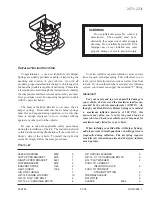
Care of your caravan
162
www.coachman.co.uk
O
w
ners h
andb
o
ok
2
02
2
Coachman Caravan Company Limited, Amsterdam Road, Sutton Fields Industrial Estate, Hull, HU7 0XF
Stubborn dirt and grease may require
the use of nylon scouring pad (such as
Scotchbrite), in conjunction with the multi-
purpose cream cleaner.
Oil, grease and fingerprints can generally
be removed with a soap/water solution but
a hydrocarbon solvent may be required.
Care must be taken to use the proper
safety precautions if using solvents.
Fingerprints, on the glass lid, can be
eliminated with a glass cleaner. Removal of
the excess cleaner with a soft cloth leaves
a protective film from which fingerprints
can be wiped.
Tannin (Tea) Stains
Tannin stains can be removed using a hot
solution of sodium carbonate (washing
soda) and water, alternatively, the solution
can be applied with a soft cloth/sponge.
This treatment should be followed by a
clean water rinse to remove any residues
and drying with a soft cloth.
Heat Tinting and Discoloration
Heavy oxidation is unlikely to occur
during normal usage. If heat tinting does
occur, slight abrasion of the surface will
be required and the type of cleaner will
depend upon the original finish of the
component. A highly polished surface will
require the use of a proprietary stainless
steel polish but slight scratching may
occur during the polishing treatment. If the
finish is directional, as in a ground, brush
or dull polish, then a nylon scouring pad/
cloth in conjunction with the multi-purpose
cream cleaner can be used.
Scratches
Scratching will be most noticeable on
highly polished components, in particular
the drainer area of sinks where hard
objects are likely to be placed during
normal household use. These marks
are usually only superficial and can be
removed with a proprietary stainless steel
cleaner/polish. A useful alternative is a car
paint restorer, such as ‘T-Cut’.
Rust Marks
Under normal usage, it is unlikely that
these marks will be caused by rusting
of the stainless steel itself, but are more
likely to be the result of small particles
of “ordinary steel” which have become
attached to the surface and subsequently
rusted. These brown marks are usually
only superficial stains and can be removed
by using a soft damp cloth and multi-
purpose cream cleaner. Occasionally, it
may be necessary to resort to a proprietary
stainless steel cleaner, to return the
surface to its original condition.
Cautions
1. Cleaning agents containing sodium
hypochlorite (bleach) should not be
left in contact with stainless steel. This
includes many of the new “trigger-
dispense” cleaning products and some
multi-purpose cream cleaners. If
bleach is necessary, it should be used
only in the strengths prescribed by the
manufacturer and never left in contact
with the surface for longer than 30
minutes, after which the stainless steel
should be rinsed thoroughly with clean
water.
















































